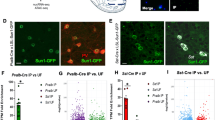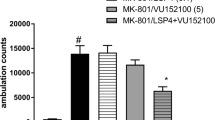Abstract
There is increasing evidence supporting the involvement of the muscarinic–cholinergic system in schizophrenia. We examined the M1 muscarinic receptor density and mRNA expression in brains of a rat amphetamine model of schizophrenia. We also assessed the effect of the model and chronic treatment with haloperidol and clozapine on brain M1 receptor density and gene expression. A significant decrease of about 20% in the density of M1 receptor was detected in the cortex and in the striatum of amphetamine model rats. A significant increase of 33% in the density of the M1 receptor was found in the cortex and striatum of rats treated chronically with clozapine (0.5 mg/kg), but not with haloperidol (25 mg/kg). Chronic clozapine, but not haloperidol, normalized the decrease in M1 receptors observed in amphetamine model rats, in both cortex and striatum. Regulation of the M1 receptor may occur in a post-transcriptional phase. Our findings suggest involvement of both dopaminergic and cholinergic–muscarinic systems in the pathophysiology and pharmacotherapy of schizophrenia.





Similar content being viewed by others
References
Baldessarini R, Tarazi F (2006) Drug therapy of psychosis and mania. In: Brunton L (ed) Goodman and Gilman’s the pharmacological basis of therapeutics, 11th edn. McGraw-Hill, New York
Barak S, Weiner I (2007) Scopolamine induces disruption of latent inhibition which is prevented by antipsychotic drugs and an acetylcholinesterase inhibitor. Neuropsychopharmacology 32:989–999
Borda T, Perez Rivera R, Joensen L et al (2002) Antibodies against cerebral M1 cholinergic muscarinic receptor from schizophrenic patients: molecular interaction. J Immunol 168:3667–3674
Boyson SJ, McGonigle P, Luthin GR et al (1988) Effects of chronic administration of neuroleptic and anticholinergic agents on densities of D2 dopamine and muscarinic cholinergic receptors in rat striatum. J Pharmacol Exp Ther 244:987–993
Bray NJ, Owen MJ (2001) Searching for schizophrenia genes. Trends Mol Med 7:169–174
Brown J, Talor P (2006) Mucarinic receptor agonists and antagonists. In: Brunton L (ed) Goodman and Gilman’s the pharmacological basis of theraputics, 11th edn. McGraw-Hill, New York
Burris KD, Molski TF, Xu C et al (2002) Aripiprazole, a novel antipsychotic, is a high-affinity partial agonist at human dopamine D2 receptors. J Pharmacol Exp Ther 302:381–389
Bymaster FP, Shannon HE, Rasmussen K et al (1999) Potential role of muscarinic receptors in schizophrenia. Life Sci 64:527–534
Bymaster FP, Felder C, Ahmed S et al (2002) Muscarinic receptors as a target for drugs treating schizophrenia. Curr Drug Targets CNS Neurol Disord 1:163–181
Chan WY, McKinzie DL, Bose S et al (2008) Allosteric modulation of the muscarinic M4 receptor as an approach to treating schizophrenia. Proc Natl Acad Sci USA 105:10978–10983
Crook JM, Dean B, Pavey G et al (1999) The binding of [3H]AF-DX 384 is reduced in the caudate-putamen of subjects with schizophrenia. Life Sci 64:1761–1771
Crook JM, Tomaskovic-Crook E, Copolov DL et al (2001) Low muscarinic receptor binding in prefrontal cortex from subjects with schizophrenia: a study of Brodmann’s areas 8, 9, 10, and 46 and the effects of neuroleptic drug treatment. Am J Psychiatry 158:918–925
Dean B, Crook JM, Pavey G et al (2000) Muscarinic1 and 2 receptor mRNA in the human caudate-putamen: no change in m1 mRNA in schizophrenia. Mol Psychiatry 5:203–207
Dean B, McLeod M, Keriakous D et al (2002) Decreased muscarinic1 receptors in the dorsolateral prefrontal cortex of subjects with schizophrenia. Mol Psychiatry 7:1083–1091
Edelstein P, Schultz JR, Hirschowitz J et al (1981) Physostigmine and lithium response in the schizophrenias. Am J Psychiatry 138:1078–1081
Feltenstein MW, Altar CA, See RE (2007) Aripiprazole blocks reinstatement of cocaine seeking in an animal model of relapse. Biol Psychiatry 61:582–590
Flynn DD, Ferrari-DiLeo G, Mash DC et al (1995) Differential regulation of molecular subtypes of muscarinic receptors in Alzheimer’s disease. J Neurochem 64:1888–1891
Gambill JD, Kornetsky C (1976) Effects of chronic d-amphetamine on social behavior of the rat: implications for an animal model of paranoid schizophrenia. Psychopharmacology (Berl) 50:215–223
Gerber DJ, Sotnikova TD, Gainetdinov RR et al (2001) Hyperactivity, elevated dopaminergic transmission, and response to amphetamine in M1 muscarinic acetylcholine receptor-deficient mice. Proc Natl Acad Sci USA 98:15312–15317
Jones CK, Eberle EL, Shaw DB et al (2005) Pharmacologic interactions between the muscarinic cholinergic and dopaminergic systems in the modulation of prepulse inhibition in rats. J Pharmacol Exp Ther 312:1055–1063
Levey AI, Kitt CA, Simonds WF et al (1991) Identification and localization of muscarinic acetylcholine receptor proteins in brain with subtype-specific antibodies. J Neurosci 11:3218–3226
Li Z, Huang M, Ichikawa J et al (2005) N-desmethylclozapine, a major metabolite of clozapine, increases cortical acetylcholine and dopamine release in vivo via stimulation of M1 muscarinic receptors. Neuropsychopharmacology 30:1986–1995
Matsumoto I, Inoue Y, Iwazaki T et al (2005) 5-HT2A and muscarinic receptors in schizophrenia: a postmortem study. Neurosci Lett 379:164–168
Miyamoto S, Duncan GE, Marx CE et al (2005) Treatments for schizophrenia: a critical review of pharmacology and mechanisms of action of antipsychotic drugs. Mol Psychiatry 10:79–104
Muller P, Seeman P (1977) Brain neurotransmitter receptors after long-term haloperidol: dopamine, acetylcholine, serotonin, alpha-noradrenergic and naloxone receptors. Life Sci 21:1751–1758
Murphy CA, Fend M, Russig H et al (2001) Latent inhibition, but not prepulse inhibition, is reduced during withdrawal from an escalating dosage schedule of amphetamine. Behav Neurosci 115:1247–1256
Raedler TJ, Knable MB, Jones DW et al (2000) In vivo olanzapine occupancy of muscarinic acetylcholine receptors in patients with schizophrenia. Neuropsychopharmacology 23:56–68
Raedler TJ, Knable MB, Jones DW et al (2003a) Central muscarinic acetylcholine receptor availability in patients treated with clozapine. Neuropsychopharmacology 28:1531–1537
Raedler TJ, Knable MB, Jones DW et al (2003b) In vivo determination of muscarinic acetylcholine receptor availability in schizophrenia. Am J Psychiatry 160:118–127
Raedler TJ, Bymaster FP, Tandon R et al (2007) Towards a muscarinic hypothesis of schizophrenia. Mol Psychiatry 12:232–246
Rehavi M, Roz N, Weizman A (2002) Chronic clozapine, but not haloperidol, treatment affects rat brain vesicular monoamine transporter 2. Eur Neuropsychopharmacol 12:261–268
Robinson TE, Becker JB (1986) Enduring changes in brain and behavior produced by chronic amphetamine administration: a review and evaluation of animal models of amphetamine psychosis. Brain Res 396:157–198
Russig H, Kovacevic A, Murphy CA et al (2003) Haloperidol and clozapine antagonise amphetamine-induced disruption of latent inhibition of conditioned taste aversion. Psychopharmacology (Berl) 170:263–270
Sadock BJ, Sadock VA (2003) Kaplan & Sadock’s synopsis of psychiatry: behavioral sciences, clinical psychiatry, 9th edn. Lippincott Williams & Wilkins, Philadelphia
See RE, Toga AW, Ellison G (1990) Autoradiographic analysis of regional alterations in brain receptors following chronic administration and withdrawal of typical and atypical neuroleptics in rats. J Neural Transm Gen Sect 82:93–109
Shekhar A, Potter WZ, Lightfoot J et al (2008) Selective muscarinic receptor agonist xanomeline as a novel treatment approach for schizophrenia. Am J Psychiatry 165:1033–1039
Silvestri S, Seeman MV, Negrete JC et al (2000) Increased dopamine D2 receptor binding after long-term treatment with antipsychotics in humans: a clinical PET study. Psychopharmacology (Berl) 152:174–180
Snyder S, Greenberg D, Yamamura HI (1974) Antischizophrenic drugs and brain cholinergic receptors. Affinity for muscarinic sites predicts extrapyramidal effects. Arch Gen Psychiatry 31:58–61
Tandon R, Greden JF (1989) Cholinergic hyperactivity and negative schizophrenic symptoms. A model of cholinergic/dopaminergic interactions in schizophrenia. Arch Gen Psychiatry 46:745–753
Tenn CC, Fletcher PJ, Kapur S (2003) Amphetamine-sensitized animals show a sensorimotor gating and neurochemical abnormality similar to that of schizophrenia. Schizophr Res 64:103–114
Tenn CC, Fletcher PJ, Kapur S (2005) A putative animal model of the “prodromal” state of schizophrenia. Biol Psychiatry 57:586–593
Terry AV Jr, Gearhart DA, Mahadik SP et al (2006) Chronic treatment with first or second generation antipsychotics in rodents: effects on high affinity nicotinic and muscarinic acetylcholine receptors in the brain. Neuroscience 140:1277–1287
Toru M, Watanabe S, Shibuya H et al (1988) Neurotransmitters, receptors and neuropeptides in post-mortem brains of chronic schizophrenic patients. Acta Psychiatr Scand 78:121–137
Tune L, Coyle JT (1980) Serum levels of anticholinergic drugs in treatment of acute extrapyramidal side effects. Arch Gen Psychiatry 37:293–297
Ushijima I, Kawano M, Kaneyuki H et al (1997) Dopaminergic and cholinergic interaction in cataleptic responses in mice. Pharmacol Biochem Behav 58:103–108
Watanabe S, Nishikawa T, Takashima M et al (1983) Increased muscarinic cholinergic receptors in prefrontal cortices of medicated schizophrenics. Life Sci 33:2187–2196
Watson M, Roeske WR, Yamamura HI (1982) [3H]pirenzepine selectively identifies a high affinity population of muscarinic cholinergic receptors in the rat cerebral cortex. Life Sci 31:2019–2023
Watson M, Roeske WR, Yamamura HI (1986a) [3H]pirenzepine and (−)-[3H]quinuclidinyl benzilate binding to rat cerebral cortical and cardiac muscarinic cholinergic sites. II. Characterization and regulation of antagonist binding to putative muscarinic subtypes. J Pharmacol Exp Ther 237:419–427
Watson M, Yamamura HI, Roeske WR (1986b) [3H]pirenzepine and (−)-[3H]quinuclidinyl benzilate binding to rat cerebral cortical and cardiac muscarinic cholinergic sites. I. Characterization and regulation of agonist binding to putative muscarinic subtypes. J Pharmacol Exp Ther 237:411–418
Weiner I (2003) The “two-headed” latent inhibition model of schizophrenia: modeling positive and negative symptoms and their treatment. Psychopharmacology (Berl) 169:257–297
Xing X, Lai M, Wang Y et al (2006) Overexpression of glucose-regulated protein 78 in colon cancer. Clin Chim Acta 364:308–315
Zavitsanou K, Katsifis A, Mattner F et al (2004) Investigation of m1/m4 muscarinic receptors in the anterior cingulate cortex in schizophrenia, bipolar disorder, and major depression disorder. Neuropsychopharmacology 29:619–625
Acknowledgments
We would like to thank Dr. Shifra Ben Dor from the Department of Biological Services in the Weizmann Institute of Science, Rehovot, Israel, for her assistance in the bioinformatic aspects of this study.
Author information
Authors and Affiliations
Corresponding author
Rights and permissions
About this article
Cite this article
Malkoff, A., Weizman, A., Gozes, I. et al. Decreased M1 muscarinic receptor density in rat amphetamine model of schizophrenia is normalized by clozapine, but not haloperidol. J Neural Transm 115, 1563–1571 (2008). https://doi.org/10.1007/s00702-008-0122-8
Received:
Accepted:
Published:
Issue Date:
DOI: https://doi.org/10.1007/s00702-008-0122-8




